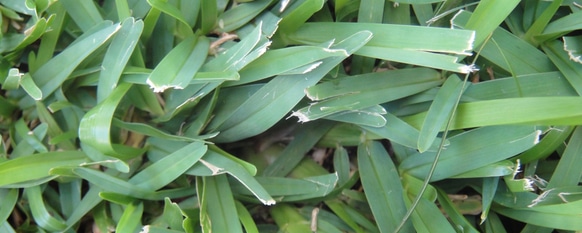Oddly named and sporting a reputation as the “lazy man’s grass,” centipede grass is an easy-care choice for homeowners and gardeners in mild climates.
This warm-season lawn grass, known botanically as Eremochloa ophiuroides, gets its moniker from its creeping growth habit and short upright stems that somewhat resemble a centipede.
In the early 1900s, it was introduced to western horticulture from its native range of China and Southeast Asia. In our lawns, it thrives in sandy acidic soils, tolerates low fertility, and has low maintenance requirements.
Little effort is needed to grow a dense, healthy centipede lawn in the warm, moist regions to which it is adapted. But it isn’t totally maintenance-free. Read on to learn more about this unusually easy grass and how to keep it looking its best.
We recommend that you also check out our guide on how to properly care for a bermuda turf lawn.

Centipede Grass General Information
Centipede is a coarse-textured, warm-season lawn grass that spreads by stolons. It offers excellent heat tolerance, moderate shade tolerance, and better than average drought-tolerance, but is susceptible to damage from extreme or extended cold weather.
It is widely recognized as a dependable, low maintenance turf with very few pests or disease problems. But some consider its apple-green color, mid-to-late summer seed heads, and coarse texture less aesthetically appealing than other warm-season grasses.
In the southeastern United States, from South Carolina to Florida, the warm, humid climate and predominantly sandy soils create an ideal environment for centipede grass to thrive. Although it browns out in the winter, where temperatures dip below 50 degrees Fahrenheit, it never enters a true dormant phase and is evergreen in the mildest parts of its range. Annual rainfall totals in excess of 50 inches per year throughout this region help to keep irrigation costs for this shallow-rooted species at a minimum.
Outside of the Southeast, centipede grows best in acidic soil where temperatures typically remain above 20 degrees Fahrenheit. Although work has been done to develop cold-tolerant cultivars, the common form is the most readily available. It handles winter temperatures as low as 5 degrees for short intervals, but struggles in long-term cold snaps and wide temperature fluctuations.

Establishing a Centipede New Lawn
This species easily grows from sod, plugs, or seeds. It prefers full sun, but tolerates as little as 6 hours of direct sunlight. Planting centipede seed is the least expensive but most labor-intensive way to go. It takes up to two full growing seasons to establish a mature lawn from seed. Most new lawn and landscape installations are sodded. It’s more expensive, but provides immediate coverage and establishes quickly.
Sow the seed on weed-free, bare soil in late spring when temperatures are consistently 80s or warmer. Lightly water the area daily. Be patient! It takes two to four weeks for the seed to germinate. Once the seedlings reach 2 inches in height, gradually reduce watering to three times per week, but increase the duration to one-third of an inch per watering.
Lay centipede sod during the late spring and summer months, at least four weeks before the first fall frost date. On hilly terrain, run the long edges parallel to the predominant slope contour and use sod staples to keep them in place. For flat ground installation, use the sidewalk or driveway as a guide. Stagger the seams between the pieces in each row, like bricks in a wall, to eliminate washouts in heavy rain.

Mondo grass is a beautiful ornamental grass to consider growing. Our mondo care guide will tell you everything you need to know on how to raise it.
Mowing
Mow the lawn at 1.5 to 2 inches. Weekly mowing is the normal practice. Be sure to keep the mower blade sharp to avoid tearing rather than cutting the grass blades cleanly. During times of drought stress, mow less frequently and avoid unnecessary foot traffic.
Watering
Although it has a high degree of heat tolerance, centipede’s relatively shallow root system makes it less drought-resistant than some other warm-season grasses.
It grows best with at least one inch of water per week from a combination of rain and irrigation. Avoid light, frequent irrigation that stimulates shallow root development. If you get no rain for a month during the winter, water the lawn to prevent desiccation.
Use a rain gauge to help determine whether or not to irrigate. Also, observe the appearance of the grass for indicators. If the grass blades look wilted or change to a gray-green color, it’s thirsty. The best time to water is in the morning between 4 and 10 a.m. At that time, less water is lost to evaporation compared with midday and late afternoon watering.
Fertilization
Good nutrition is a key to cold tolerance and lush, healthy foliage. Centipede is a thrifty lawn that needs less fertilizer than other warm-season grasses. It also prefers more acidic soil with a pH of 5.0 to 6.0.
Each lawn and soil type is different, so test yours annually to determine fertility requirements. Follow the recommendations provided with the test results.
Feed the lawn at spring green up, when the grass is halfway through its transition from brown to green, and again in early-late summer or early fall. In the absence of soil test results, apply 1 pound of nitrogen per 1000 square feet. Where potassium is lacking, apply it during the spring and fall feedings to promote healthy root development.

Weed and Pest Control
Few problems develop in a well-maintained lawn. Give it good fertility, mow regularly, and water when necessary.
Centipede is sensitive to iron deficiency, which makes the grass take on a pale yellow-green color. Treating with an iron supplement may help temporarily. Chlorosis could also be an indication of a pH problem. Test the soil to determine the proper corrective action. If the pH is too high, apply sulfur in spring or fall to bring it into the proper range.
Centipede grass decline is a generic term for dieback caused by a variety of problems. Essentially the lawn is unhealthy, but we don’t know why. Some of the common causes include over-fertilization, compacted soil, thatch buildup, and high pH. If the lawn shows signs of stress, look for clues. Test the soil. Avoid over-fertilization, and never fertilize during winter dormancy. Aerate or dethatch as needed.
The best defense against weeds is a dense, robust turf. Give it the best growing environment to help it compete. Sometimes weeds still invade. Pre and post-emergent herbicides can help. Only use products specifically labeled for use on centipede grass.
Apply pre-emergent herbicides in late winter and late summer to prevent seeds of annual summer or winter weeds like crabgrass, poa annua, chickweed, and others from sprouting in the first place. Post-emergent weed killers help control existing weeds. They are most effective while the weeds are young and actively growing.
Centipede grass offers a low-input, easy-care lawn choice for mild climates. It naturally thrives in heat, humidity, and acid soils where other grasses struggle and uses half the fertilizer or less. It is not suitable for heavy traffic. And some may not find its light shade of green less appealing. But if you need a tough, dependable groundcover without the fuss, this one is hard to beat.



Great article, I wonder if this grass on the side of my yard and backyard is centipede grass? It doesn’t really seem to grow. It reminds me of the grass that is on the golf course…
Usually golf courses use Bermuda grass or Zoysia grass. We have guides on those on this site as well